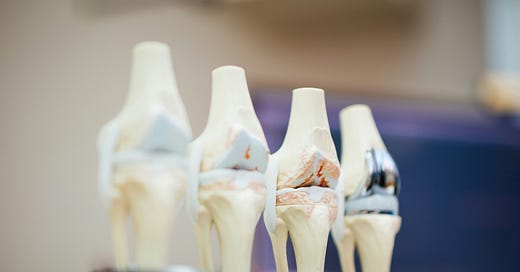Using Xray To Diagnose OA Might Be WORSE Than Not Using Xray?!?
Welcome back Rheumatology Fans,
Xrays and Osteoarthritis has come to my attention again. I don’t know if “gained noteriety” is the right turn of phrase for some of the outcomes related to me posting about this on social media, but it has certainly brought some aggro my way. Not as much as posting about Hypermobility Syndromes but definitely in second place.
I commonly get responses:
“its cheap and harmless, why not xray”
“I once saw (insert horrendous diagnosis) that I would have missed without xray”
“shut up”
Anyway, moving on…
THIS STUDY - which is interesting in its design as well as the topic looked at explaining the diagnosis of Osteoarthritis with and without the use of xrays and the conclusion was
An X-ray–based diagnosis and explanation of knee OA may have potentially undesirable effects on people’s beliefs about management.
I am trying really hard not to just add this to my belief system without proper critique because it does agree with my bias. Read on for more about this interesting study. I have some thoughts. They might help you in the clinic. Hopefully, they do not enrage you. My fingers are crossed on that one, I feel like I am getting old and don’t have the energy for full blown arguments…
Indulge me a little talking about study design, the authors readily accept the limitations which were clearly done for pragmatism.
THE STUDY
600+ people were split into 3 groups, presented with a scenario (you have had 6 months knee pain and have a GP appointment), they were played one of 3 videos and then filled in an online survey.
The 3 videos were
Clinical explanation
Radiographic explanation (no xrays)
Radiographic explanation (showing xrays)
The questionnaire assessed thoughts about the necessity of surgery and beliefs about the helpfulness of exercise/physical activity. The boiled-down version of the results is people shown video one thought surgery was less necessary. Otherwise, there was no clear difference between groups.
A major limitation is that this was all hypothetical, would the one finding of a difference be eliminated or increased? Would the other (no difference) outcomes show more difference? I actually have no idea.
The study also found slightly more satisfaction with the consultation on the radiographic explanation which I think will be used to justify xrays instead of what it probably means. That patients expect an xray and their expectations were met, not that it was actually better.
MY THOUGHTS
NICE guidelines on diagnosing Osteoarthritis:
1.1 Diagnosis
1.1.1 Diagnose osteoarthritis clinically without imaging in people who:
are 45 or over and
have activity-related joint pain and
have either no morning joint-related stiffness or morning stiffness that lasts no longer than 30 minutes.
1.1.2 Do not routinely use imaging to diagnose osteoarthritis unless there are atypical features or features that suggest an alternative or additional diagnosis.
Which you can watch me agree with here
Continue with this approach, if your patient satisfies these criteria, crack on. Diagnose OA as appropriate; don’t get those xrays. If your patient doesn’t meet the criteria, clinically reason appropriately. If they want xrays to confirm the diagnosis, it isn’t always easy to dissuade them but it is on you to try.
IF YOU HAVE XRAYS (you got them or someone else did) and the prevailing diagnosis is Osteoarthritis:
Explain the condition, (this study shows) there is no difference between showing the person the images and not so I would ask them if they want to see them and go with that.
Concentrate on the fact that surgery is not always required or inevitable and the good outcomes with conservative management. Explore their beliefs and intervene where you can and where is appropriate. especially if they think they are destined for surgery.
Finally
My bias is that less imaging is better and this adds a little fuel to that fire, people will come to be shredding this to smithereens. Fine. If you do that, please don’t ignore the points that are raised even if this study is a small stepping stone to real world application.
Kudos to these researchers. FASCINATING DESIGN.








